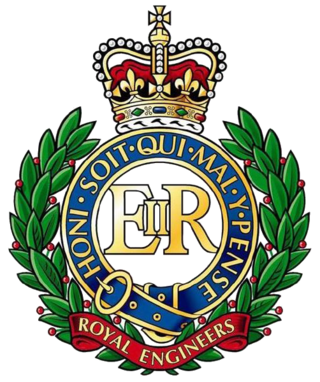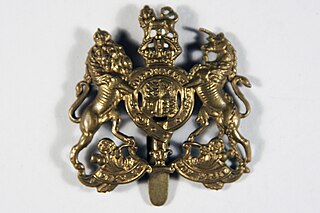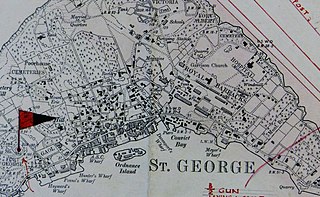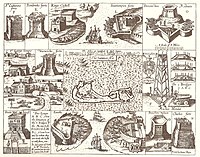History
Bermuda was settled inadvertently, in 1609, by the Virginia Company. Its first deliberate settlers arrived in 1612, aboard the Plough. The very first concern of the first Governor, Richard Moore, was the Colony's defences against an expected Spanish attack. He oversaw the immediate construction of fortifications around St. George's and Castle Harbour, and raised militias to man the defences. The military defences would remain wholly the responsibility of the Colonial Government until an independent company of army soldiers was garrisoned in Bermuda from 1701. The Colonial Militia included bodies of artillery, infantry, and mounted troops. After American independence, the Royal Navy began building up a base on Bermuda. This resulted in a parallel build-up of the British Army's Bermuda Garrison, intended to protect the naval base. Bermuda's militias had long suffered from the Colony's maritime industry, which ensured that much of its useful manpower was always away, at sea. With the increase in the number of regular soldiers, the Islanders lost what interest they had in maintaining militias. By the time the United States declared war in 1812, the Bermudian militia had become moribund, with the last, 1802, Militia Act having been allowed to lapse. An Act was rushed through, as a war-time expediency, in 1813, but the militia was allowed to lapse again after the War's end in 1815. The British Government made repeated pleas for Militia to be maintained, but, other than short-lived militias raised by the Governor, or the Royal Navy, without an Act, or the funding, of the Colonial Parliament, no part-time Bermudian units would be raised until the formation of Volunteer Army units in 1895.
Bermudians also raised militias from the seasonal population on the Turks Islands, which Bermuda had effective control of from about 1681 until the British government assigned them to the Bahamas at the end of the Eighteenth Century. Spanish and French forces seized the Turks in 1706, but Bermudian forces expelled them four years later in what was probably Bermuda's only independent military action.

Bermuda was first documented by a European in 1503 by Spanish explorer Juan de Bermúdez. In 1609, the English Virginia Company, which had established Jamestown in Virginia two years earlier, permanently settled Bermuda in the aftermath of a hurricane, when the crew and passengers of Sea Venture steered the ship onto the surrounding reef to prevent it from sinking, then landed ashore. Bermuda's first capital, St. George's, was established in 1612.

While the defence of Bermuda remains the responsibility of the government of the United Kingdom, rather than of the local Bermudian Government, the island still maintains a militia for the purpose of defence.

Between 1612 and 1687, Bermuda had a series of militias under the Virginia Company, the Somers Isles Company, and the British Crown. In 1687, the first Militia Act was enacted.
Bermuda Militia, under Militia Acts 1687–1813. Although the Bermuda Parliament had been formed in 1620, prior to 1687, the Bermudian Militia was raised and organised without reference to a Militia Act. The Crown took over the administration of the Colony from The Somers Isles Company in 1684.
With the start of the American War of 1812, an Act of 1813 re-organized the Military of Bermuda's nine-company regiment of foot into two battalions. The total strength of the local militia was, by then, nominally 450 men, but, as always, this was, at any moment, effectively reduced by half due to the seafaring occupations of the better part of the colony's men. Evidently, the militia no longer included any of the colony's black population, whether free or enslaved, as Lt. Colonel Francis Gore, on assuming the governorship, felt it advisable to boost the militia's strength by raising a colored corps, though this was not, in fact, done.

The Bermuda Volunteer Rifle Corps (BVRC) was created in 1894 as a reserve for the Regular Army infantry component of the Bermuda Garrison. Renamed the Bermuda Rifles in 1951, it was amalgamated into the Bermuda Regiment in 1965.
Arthur Rowe Spurling, was a Bermudian who served during the First World War as an infantryman and an aviator, becoming an ace credited with six aerial victories. He later served as a ferry pilot during the Second World War.

The Bermuda Garrison was the military establishment maintained on the British Overseas Territory and Imperial fortress of Bermuda by the regular British Army and its local militia and voluntary reserves from 1701 to 1957. The garrison evolved from an independent company, to a company of Royal Garrison Battalion during the American War of Independence, and a steadily growing and diversifying force of artillery and infantry with various supporting corps from the French Revolution onwards. During the American War of Independence, the garrison in Bermuda fell under the military Commander-in-Chief of America. Subsequently, it was part of the Nova Scotia Command until 1868, and was an independent Bermuda Command from then until its closure in 1957.

The Bermuda Flying School operated on Darrell's Island from 1940 to 1942. It trained Bermudian volunteers as pilots for the Royal Air Force and the Fleet Air Arm.

The Bermuda Volunteer Engineers was a part-time unit created between the two world wars to replace the Regular Royal Engineers detachment, which was withdrawn from the Bermuda Garrison in 1928.
Colonel Sir Richard Masters Gorham KB, CBE, DFC, JP was a prominent Bermudian parliamentarian, businessman and philanthropist, who served as a pilot during the Second World War when he played a decisive role in the Battle of Monte Cassino, earning the Distinguished Flying Cross.
Major Cecil Montgomery-Moore DFC was an American-born Bermudian First World War fighter pilot, and commander of the Bermuda Volunteer Engineers and the Bermuda Flying School during the Second World War.

Fort St. Catherine, or Fort St. Catherine's, is a coastal artillery fort at the North-East tip of St. George's Island, in the Imperial fortress colony of Bermuda. Successively redeveloped, the fort was used first by Bermudian Militia and then by regular Royal Artillery units from 1612 into the 20th century. Today it houses a museum.

The Historic Town of St George and Related Fortifications is the name used by the United Nations Educational, Scientific and Cultural Organization's (UNESCO) World Heritage Committee to identify collectively as a World Heritage Site St. George's Town, founded in 1612, and a range of fortifications, batteries, and magazines built between 1612 and 1939, the last of which was removed from use in 1953.

St. David's Battery, also known during wartime as the "Examination Battery", was a fixed battery of rifled breech-loader (RBL) artillery guns, built and manned by the Royal Garrison Artillery and the Royal Engineers, and their part-time reserves, the Bermuda Militia Artillery and the Bermuda Volunteer Engineers, part of the Bermuda Garrison of the British Army.

The Bermuda Base Command was a command of the United States Army, established to defend the British Colony of Bermuda, located 640 miles off Cape Hatteras, North Carolina. It was created in April 1941 when United States Army troops were sent to the island.
The Militia of the British Dominions, Self-Governing Colonies, and Crown Colonies were the principal military forces of the Dominions, Self-governing colonies and Crown Colonies of the British Empire.

Fort Victoria is a disused British Army fort, built to house coastal artillery atop Retreat Hill, within St. George's Garrison, at the North-East of St. George's Island, in the British colony of Bermuda.

The Bermuda Militia Infantry was raised in 1939 as a part-time reserve of the British Army's Bermuda Garrison.

St. George's Garrison was the first permanent military camp of the Bermuda Garrison established in the British colony and Imperial fortress of Bermuda, with construction of Old Military Road and the original Royal Barracks commencing during the war between Britain and France that followed the French Revolution. It would remain in use until 1957, when it was transferred to the civil (colonial) government with most of the other Admiralty and War Office properties in Bermuda.














